208
A very personal subject, my impressions of this product! Navy: There are several options. Hormonal, with silver, copper...
Find yours, reliable It is not an easy task for a modern woman. To make the right choice of contraceptives will help knowledge about your body and the recommendations of an experienced gynecologist.

DepositPhotos
Contraception that is effective for some can be completely useless for others. That’s right, it all depends on individual characteristics. To evaluate this very effectiveness, there is a special medical term. pearl. The lower it is, the more reliable the method of protection.
For example, the index of sexual intercourse without protection is 50–75, condoms 2–4, tablet hormonal contraceptives 0.1–0.9. For vaginal suppositories, tablets, creams and similar drugs, the index is 3–21. For the intrauterine device - 0.9-3. This is what we will talk about in today’s article.

The intrauterine device (IUD) is a device that is inserted into the uterine cavity and mechanically prevents unwanted pregnancy. Modern Navy is made of plastic with the content of copper, gold, silver, hormones (progestin). The spiral as a popular mechanical contraceptive is T-shaped, spiral, ring-shaped.
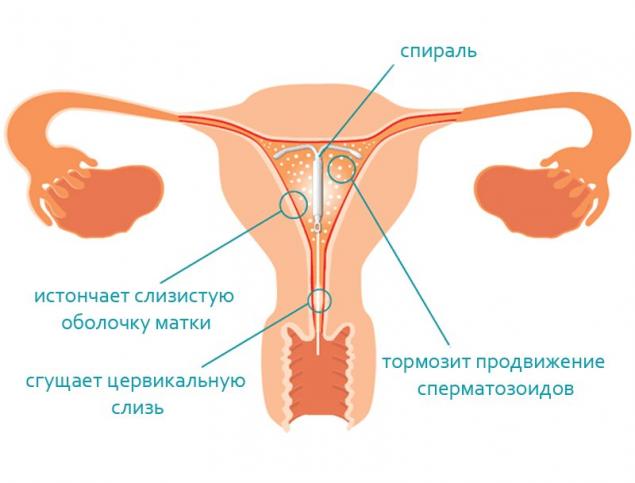
It works on the principle of an irritant, while increasing the production of phagocytes - blood cells that absorb and digest foreign protein particles. The inner surface of the uterus creates and maintains an unfavorable environment in constant readiness. Sperm that have penetrated into the uterine cavity die without getting into the fallopian tubes. This also applies to the fetal egg at an early stage.
A reliable contraception is very important. Ideally, it is necessary to make a decision on the use of contraceptives together with a partner, under the guidance of a competent doctor.
If the article was useful for you, show it to your friends, it will help you make the right choice.

DepositPhotos
Contraception that is effective for some can be completely useless for others. That’s right, it all depends on individual characteristics. To evaluate this very effectiveness, there is a special medical term. pearl. The lower it is, the more reliable the method of protection.
For example, the index of sexual intercourse without protection is 50–75, condoms 2–4, tablet hormonal contraceptives 0.1–0.9. For vaginal suppositories, tablets, creams and similar drugs, the index is 3–21. For the intrauterine device - 0.9-3. This is what we will talk about in today’s article.

The intrauterine device (IUD) is a device that is inserted into the uterine cavity and mechanically prevents unwanted pregnancy. Modern Navy is made of plastic with the content of copper, gold, silver, hormones (progestin). The spiral as a popular mechanical contraceptive is T-shaped, spiral, ring-shaped.

It works on the principle of an irritant, while increasing the production of phagocytes - blood cells that absorb and digest foreign protein particles. The inner surface of the uterus creates and maintains an unfavorable environment in constant readiness. Sperm that have penetrated into the uterine cavity die without getting into the fallopian tubes. This also applies to the fetal egg at an early stage.
- Working principle Copper in the IUD has a cytotoxic effect on sperm and blastocyst (early stage of embryo development, up to 7 days). The mucous membrane becomes destructive due to copper compounds. The spiral causes increased mobility of the fallopian tubes, during ovulation, the egg passes through them 5 times faster. At the same time, the level of prostaglandin increases, which does not allow the egg to be reliably fixed in the uterine cavity. Without finding a place for implantation, the egg leaves the body with the nearest menstruation.
- Advantages This method of contraception is highly effective, about 97%, and low cost, taking into account the long-term contraceptive effect. The intrauterine device can be used by recently given birth and lactating women, it does not affect lactation.
The spiral is convenient to use, does not require additional preparation before sexual intercourse and does not create discomfort. It is set for a period of 3-5 years. After removal of the IUD, the reproductive function is maintained.
You do not need to monitor the hourly intake, as with birth control pills and avoid certain foods (with tablets you can not grapefruit juice, and with a spiral you can). Smoking and alcohol do not affect the contraceptive effect.
It is possible to use in the case of emergency contraception - the spiral is inserted immediately after unprotected sexual intercourse.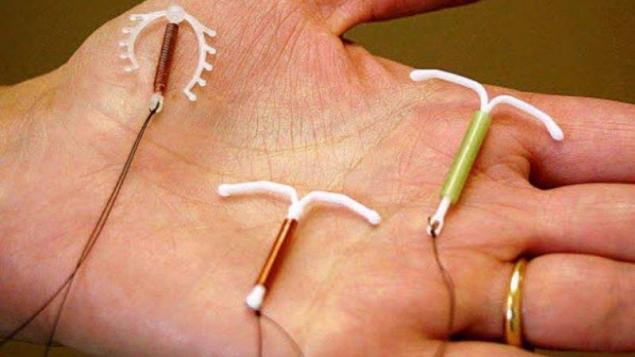
Hormonal intrauterine devices, in addition to contraceptive function, have therapeutic. Cyclic release of hormones is justified in endometriosis, mastopathy, growth of uterine fibroids, some inflammatory diseases. - Deficiencies Like most medical manipulations, the spiral has its drawbacks. Since it is a foreign body in the body of a woman, the likelihood of inflammatory processes in the pelvic organs increases. In addition, the spiral can fall unnoticed. In some women, it does not take root at all.
It is strictly forbidden to install an intrauterine device for non-parenting women. A possible inflammatory process can provoke infertility.
Menstruation with a spiral often becomes more painful, bleeding is more abundant. The risk of ectopic pregnancy, spontaneous abortion and perforation of the uterus (rupture of the walls) increases.
DepositPhotos
“When using the intrauterine device, pregnancy occurs in about 10% of cases, and often it is ectopic.”
Spiral does not protect against sexually transmitted infections. It is installed in the uterus so that the cervix remains slightly open and the risk of infection increases. At the same time, the severity of complications and the general course of the inflammatory process is much higher. Therefore, the spiral is recommended for women with a permanent sexual partner.
The disadvantages of the spiral include the inconvenience that occurs after its installation. This discomfort in the lower abdomen, bloody discharge and changes in the usual rhythm of life. During the month, you should refrain from visiting the pool, sauna, bath, avoid physical exertion. - Before installation The introduction of an intrauterine device is a common medical procedure. It is carried out exclusively in the gynecological office by the appropriate specialist.

DepositPhotos
To assess the degree of risk, it is recommended to pass gynaecological examination. It includes examination of the cervix, smears, cytology, colposcopy, ultrasound of the pelvic and breast organs.
With an unstable partner or with uncertainty in a permanent partner - analysis for sexual infections. If inflammatory processes are detected, appropriate treatment will be required.
Make sure you are not allergic to metals. At the time of setting the spiral, pregnancy should be excluded. This is done using a test or blood test to determine the level of hCG. - Absolute contraindications Installation of the IUD is not possible in the case of a confirmed pregnancy at any time or pregnancies. Oncological diseases of the genital organs and breast cancer are contraindications.
198346
DepositPhotos
Acute course or detection of chronic infections such as adnexitis, colpitis, endometritis, salpingitis requires immediate treatment, with the installation will have to wait. Also, the IUD is not administered to women who have sexually transmitted infections, tuberculosis of the reproductive system, HIV infection at the stage of AIDS.
IUD use is prohibited for women who have previously had ectopic pregnancies. - Relative contraindications In such cases, the decision is made by the doctor, taking into account the possible risks. If we talk about hormone-freeThis includes age over 65 years, dysplasia and cervical abnormalities, benign tumors, chronic urinary tract diseases and hematological diseases.
For hormonal Relative contraindications are all the pathologies listed above, as well as liver disease and liver failure, severe cardiovascular pathologies.
Possible complications post-helix in people with malignant hypertension, a condition after a stroke or heart attack. This should include severe heart defects, migraine, uncontrolled diabetes, thrombophlebitis of the lower extremities. - When to install? Intrauterine contraceptives are installed on the 3rd day of menstruation or closer to their completion. This is necessary to prevent pregnancy. In the case of unprotected sexual intercourse, the spiral is established after ovulation, in 75% of cases, the attachment of the fetal egg does not occur.
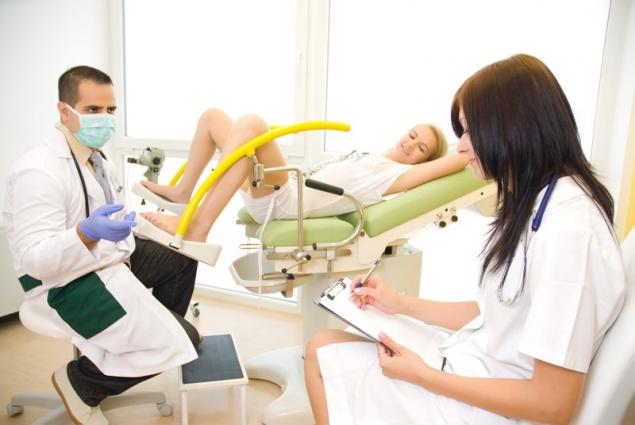
DepositPhotos
Possible introduction of the IUD for 3 days postphysiologicwhich went without complications. But gynecologists advise to wait a month and a half, during this time the uterus will return to normal and the probability of rejection of the device will be lower.
If the operation was carried out caesareanThe spiral can be installed after the formation of a postoperative scar. This is in about 3-6 months.
After termination of pregnancy for up to 12 weeks, the IUD is installed within seven days after the onset of the next menstruation. Right after surgery. insertion not recommended, this is associated with the risk of side effects associated with complications of the abortion itself. - Does it hurt or not? The procedure takes no more than 15 minutes. Naturally, there is some discomfort, which depends on the individual pain threshold. It's like a painful period. Abortion and childbirth, of course, are much more painful.
The uterus completely gets used to the spiral within 3-4 months. During this time, there are some changes in the female body. There may be no prolonged pulling pain in the lower abdomen, bloody discharge (no more than 2 weeks).
Sometimes a course of antibacterial therapy is required. Genital hygiene remains unchanged, intimacy is allowed 14 days after installation. After 2 weeks, you should undergo a gynecological examination.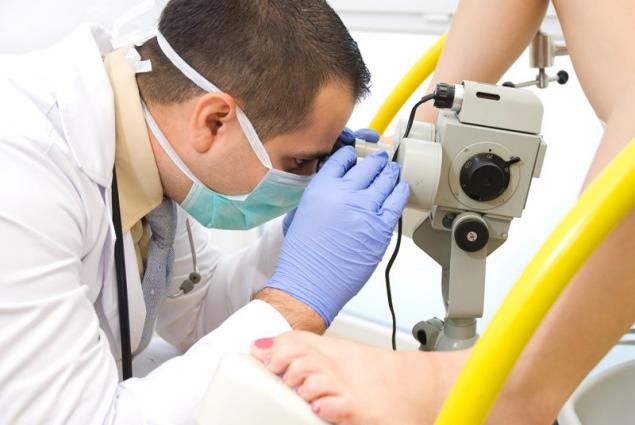
DepositPhotos
Menstruation in the first half of the year can be longer and abundant, sometimes painful.
When using hormonal intrauterine systems after six months or several years, menstruation (amenorrhea) may disappear. After the first loss of the cycle, pregnancy should be excluded. The menstrual cycle will be restored as soon as the spiral is removed.”
Remember, any violation of the general condition is a reason to consult a doctor. - How do we move on? Remember to visit your gynecologist every 6 months. Periodically probe the strands of the spiral, their length should remain unchanged. Most often, the IUD falls out after strong physical exertion and during menstruation. Check the pads after hygienic procedures.
The use of the spiral is up to 5 years, but the question of premature removal is decided by the doctor. Don't try to do it yourself! There is a serious threat to health and life if the spiral has grown and you try to pull it out! - Side effects
When choosing an IUD, you need to take into account that some women may have intolerance and the development of side effects. Some of them can lead to severe pathologies. Choose a suitable contraceptive with a professional gynecologist who will install the device in the uterine cavity. See the table with possible violations after the introduction of the IUD.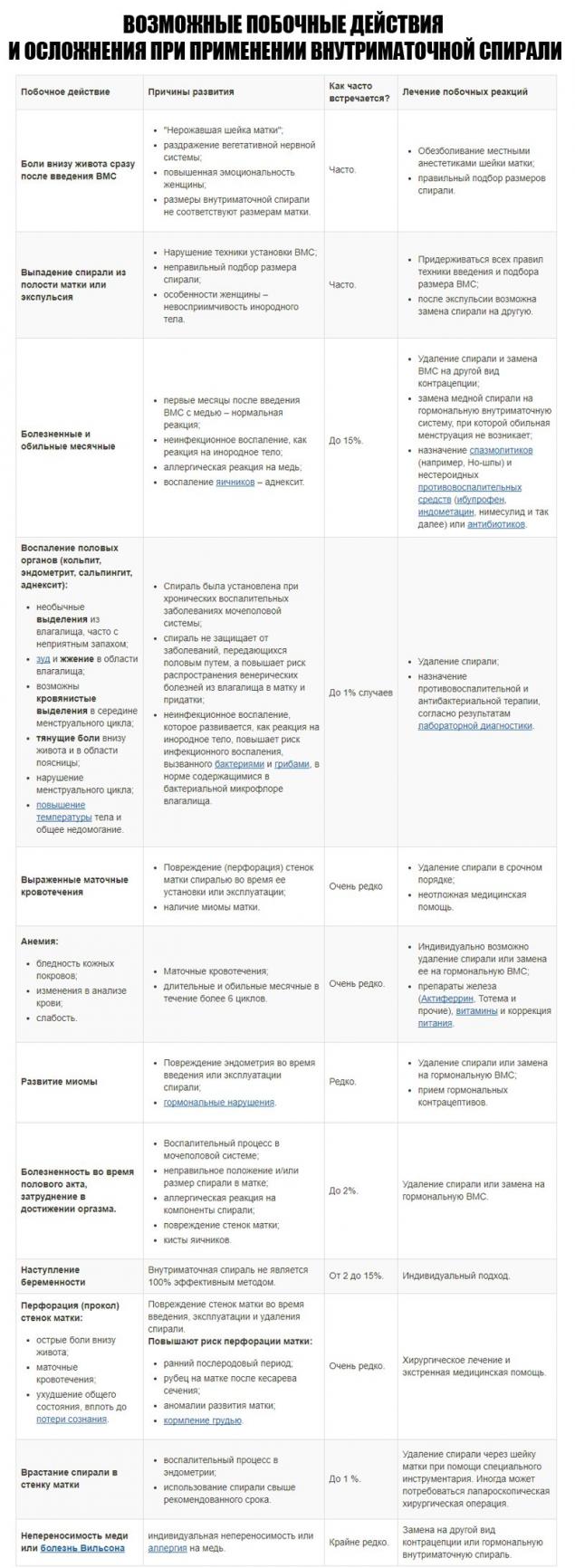
With regard to hormonal spirals, side effects should include: lack of menstruation, functional ovarian cysts, increased body weight, swelling, acne, increased hair growth in atypical places (mustache, skin of the hands, legs), swelling of the mammary glands, irritability and headaches, nausea, increased gas formation, abdominal pain, changes in blood pressure.
A reliable contraception is very important. Ideally, it is necessary to make a decision on the use of contraceptives together with a partner, under the guidance of a competent doctor.
If the article was useful for you, show it to your friends, it will help you make the right choice.
Every year, oranges are dry, everyone likes it, guests are mammoth! After a couple of hours, I open...
This powerful oil will rid the body of parasites and cholesterol, strengthen the immune system, and as for the thymus gland ...





























